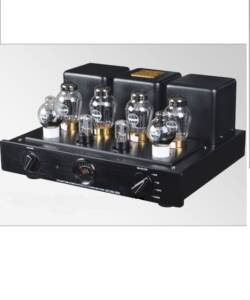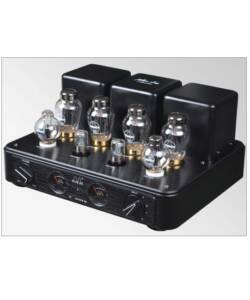Rotel RB-1090 (380W/8Ohm) Power amplifier [Black Face]
Original price was: R65,000.00.R26,000.00Current price is: R26,000.00.
Because the RB-1090 is rated only into a minimum power of 4 ohms, and also to avoid thermal risk to our test-bench load, I ran the continuous THD+noise vs output power curves only into 4 and 8 ohms. As fig.9 shows, there is clearly no shortage of power with this amp.
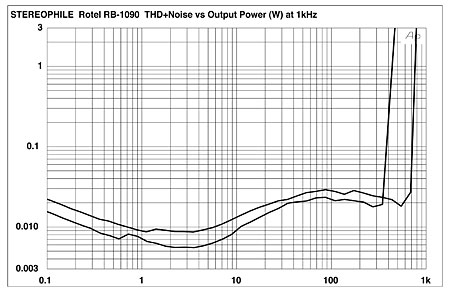
I also ran discrete clipping measurements with a continuous signal, but only into 8 ohms, again because of test-load limits. Into 8 ohms, both channels driven, the Rotel clipped (1% THD+N, to the nearest watt) at 407W (26.1dBW) in the left channel (power line 114V), and 410W (26.1dBW) in the right (power line 114V). With one channel driven, clipping occurred at 437W (26.4dBW, 116V line).
Description:
Solid-state stereo power amplifier.
Power output: 380Wpc into 8 ohms (25.8dBW), 700Wpc into 4 ohms, (25.4dBW), both 20Hz–20kHz, <0.03%.
THD: <0.03%. IM distortion (60Hz:7kHz, 4:1): <0.03%.
Frequency response: 10Hz–100kHz, ±1dB.
Damping factor (20Hz–20kHz, 8 ohms): 1000.
Speaker impedance (combined): 4 ohms minimum. S/N ratio (IHF A network): 125dB.
Input impedance/sensitivity: 33k ohms/1.8V.
THX Ultra certified.
Power consumption: 800W.
Dimensions: 17 3/8″ W by 9½” H by 15¾” D. Weight: 83.6 lbs.
Description
An amplifier producing nearly 400Wpc, weighing close to 100 lbs…from Rotel, of all people? Don’t they know their place in the audio world? Next thing you know, Krell will start making integrated amplifiers! Oops—Krell is making integrated amplifiers…
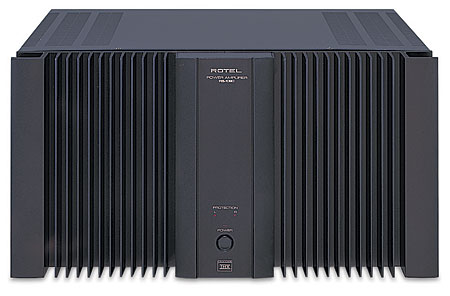
Although Rotel is indeed best known for products like entry-level integrated amplifiers, CD players, and modest-output power amplifiers, building a high-power amplifier is not as much of a stretch for them as it might seem. Back in 1996, in Stereophile Guide to Home Theater, I reviewed their RB-985 home-theater amplifier, which puts out five channels of 100W, and that might be considered equivalent to a 250Wpc stereo amplifier. More recently, in Stereophile, Bob Reina reviewed Rotel’s RB-991 (July 1999, Vol.22 No.7), a stereo amp with a healthy 200Wpc. The RB-1090 is the flagship of Rotel’s current lineup of power amps, which share styling and general design.
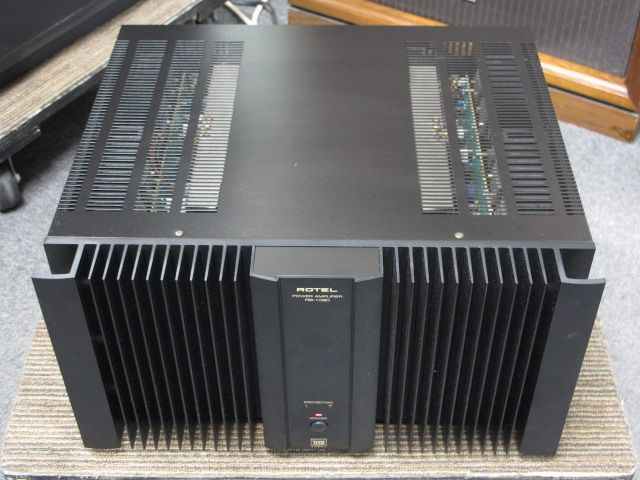
Description and design
The RB-1090 is a compact, chunky-looking amplifier—kind of like an RB-991 on steroids. Its 9½” height would make it difficult to squeeze into the typical equipment rack, but, in any case, it’s too heavy for most multiple-shelf racks—the best place for it is on the floor or on an amplifier stand. (I used the excellent PolyCrystal stand.) The Rotel folks have obviously given some thought to making the RB-1090 easy to move: rather than feet in the rear, the amplifier has wheels.
The front of the amplifier is dominated by what appears to be a sculpted heatsink. Rotel’s Mike Bartlett told me that this can function as a heatsink, and does so in their new 200Wpc 5-channel home-theater amplifier based on the same chassis, but in the RB-1090 its function is mostly cosmetic, keeping the styling consistent across models; the actual heatsinks are internal. The RB-1090 runs quite cool for a high-powered amplifier, so those internal heatsinks must be effective.
The RB-1090’s rear sports unbalanced RCA and balanced XLR connectors, with a toggle switch to select between them. There are two sets of 5-way binding posts of the standard plastic-knobbed variety. The chassis cover is made of fairly thin sheet metal, but fit’n’finish are otherwise more than commensurate with the $1999 price.
The RB-1090 is described by Rotel as being two totally separate power amplifiers sharing the same chassis and power cord. There are two independent power supplies, each with its own 1.25kVA custom-made transformer and four 2200µF BHC Slit Foil storage capacitors. The output stage consists of four pairs of Toshiba high-current transistors, each rated at 17 amps. Protection circuitry monitors the temperature of the output devices and shuts down the amplifier if safe temperature limits are exceeded. The RB-1090 also includes overcurrent protection, which operates when the load impedance drops below 2 ohms. Front-panel LEDs—one per channel—indicate the operation of the protection circuitry.

Although the RB-1090’s formal specifications state the minimum combined load as 4 ohms, the manual refers to the amplifier’s ability to “drive difficult loads with ease, including 2 ohm speakers.” When queried about this apparent inconsistency, Mike Bartlett told me that the specifications refer to continuous testing into a fixed resistance; the RB-1090 meets the ETL/UL safety specs at 4 ohms. To produce an amplifier that can handle a 2-ohm resistive load at full continuous power would incur a major cost penalty; arguably, that amplifier would be no better at driving loudspeakers.
Rotel refers to “Balanced Design” in their literature, and the RB-1 has balanced inputs, so one might think that the amp is a balanced design in the same way that products from companies like Balanced Audio Technology are balanced. It’s not. Like virtually all moderately priced amplifiers with balanced input connectors, the Rotel is what some call “pseudo-balanced,” in that the circuitry itself is unbalanced; balanced input signals are converted to unbalanced internally. It’s been my experience that any superiority of balanced connections is evident only if the preamplifier and amplifier are both fully-balanced designs, and that balanced connections used between two components that are internally unbalanced can actually degrade the sound. Unless your preamplifier is fully balanced, my advice would be to use the unbalanced connection even if the preamplifier has balanced outputs. This way, you bypass one unbalanced-to-balanced and one balanced-to-unbalanced conversion step.
If the RB-1090 is not fully balanced, then why does Rotel refer to it as having “Balanced Design”? I’m sure there is no intent to mislead; their use of the term describes a design process in which all aspects of technical and sonic performance are given equal emphasis, and money is spent where it counts: in careful parts selection and use. Considering the RB-1090 as evidence, it’s hard to argue with Rotel’s design approach.
Sound
Some audiophiles interpret the “less is more” principle as meaning that a low-power amplifier will almost invariably sound better than a high-power amplifier of similar design. They point out that most of the time the power drawn from an amplifier is less than a watt, and it’s that first watt that is critical to musical reproduction. “If the first watt doesn’t sound right, why would you want 399 more of them?” Presumably, it’s easier to get the first watt right if the amplifier has to produce only 40W, not 400W (or, in the case of certain single-ended-triode tube amps, 5W).
To an extent, this argument makes sense. With greater power comes greater circuit complexity and more output devices to be matched. Smaller can be qualitatively better; unfortunately, the majority of today’s speakers require substantial power, and many audiophiles want to play their systems at levels outside the capabilities of low-power amplifiers. What would be good to have is a high-power amplifier that sounds like a low-power amplifier except when it comes to maximum loudness capability. And that just about describes the RB-1090. Put another way, the Rotel engineers have assuredly got that first watt right.

Use of the term “listening fatigue” has fallen into disfavor among audiophiles, but Stereophile founder J. Gordon Holt did include it in his book, The Audio Glossary. Gordon defines listening fatigue as “a psychoacoustical phenomenon whereby prolonged listening to reproduced sound which is not noticeably dirty nevertheless causes increasing physical and psychological discomfort.” Listening fatigue is something that sneaks up on you, and a component that produces low listening fatigue often doesn’t have as much immediate appeal as one that provides greater detail and more punchy dynamics. I believe listening fatigue is a phenomenon all audiophiles have experienced from time to time, and is a major cause of eventual dissatisfaction with equipment that initially seemed exciting to listen to. Solid-state electronics have a hard time keeping listening fatigue in check without giving up the detail and transparency that audiophiles crave. (Tube amplifiers are less prone to induce listening fatigue, but have problems of their own.)
The level of listening fatigue engendered by the Rotel RB-1090 is one of the lowest I’ve encountered in a solid-state amplifier. In this respect, it reminded me of amplifiers from Rowland and YBA—pretty good company for a $2000 amplifier! With the RB-1090 in the system, I could listen to music for long periods and feel little inclination to change amplifiers.
The RB-1090’s other major strength was its harmonic accuracy: the ability of an amplifier to preserve the distinctive timbres of voices and musical instruments. Many solid-state amplifiers—even some very expensive ones—have a problem in this area, giving music a somewhat unnatural, “electronic” quality. Not the RB-1090. Trumpets sounded like trumpets; violins sounded like violins rather than synthesized versions thereof. Voices had much of the “rounded” quality they have in real life, with sibilants neither softened nor artificially enhanced.
Of course, no component can create this sort of natural quality if it’s not contained in the recording, and an amplifier is part of a system of sound reproduction in which every component is dependent on the contributions of the rest. Though my reviewing system is more expensive than the typical one in which the RB-1090 is likely to be used, there was no indication that the amplifier was being outclassed by the other components.
In keeping with Rotel’s avowed intention to offer “Balanced Design,” the RB-1090 neglected none of the other amplifier characteristics that audiophiles value. Detail was good without being overly analytical. The soundstage (again, very dependent on other components, especially the speakers) was deep and wide when the recording had those characteristics; the ebb and flow of music was rendered with subtlety, and the bass had admirable firmness and good extension.
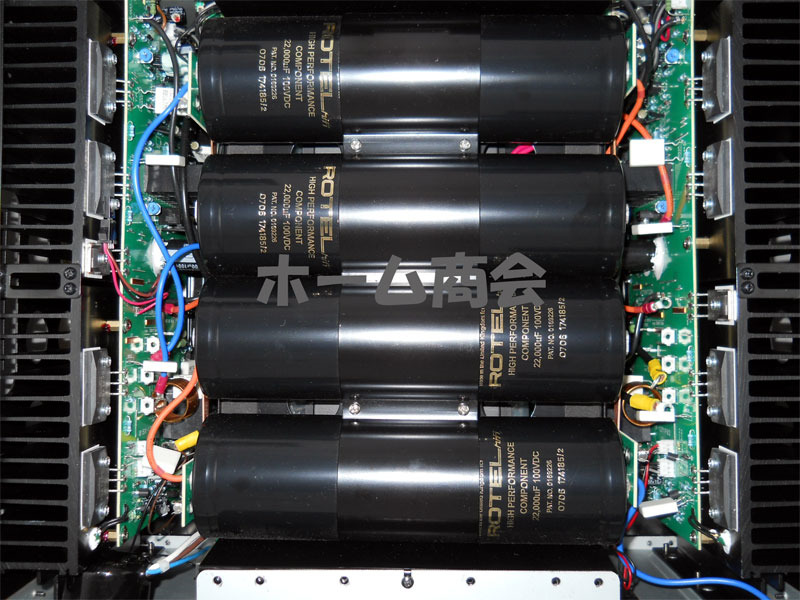
Rotel vs Parasound
Much of my time with the RB-1090 was spent comparing it to the similarly priced ($2195) Parasound HCA-3500, reviewed elsewhere in this issue (footnote 1). Designed by the legendary John Curl, the HCA-3500 features full dual-mono construction, with even bigger transformers and higher power-supply capacitance than the Rotel (1.4kVA/97,600µF vs 1.25kVA/88,000µF). Although the Parasound is rated at 350W to the Rotel’s 380W, the Parasound seemed to have more dynamic headroom: it sounded more comfortable playing music at very high levels—higher than I normally listen—where the Rotel started to sound a bit compressed. The Parasound was also superior in controlling the Dunlavy SC-IV/As’ woofers, bass having greater extension and punch.
In all other respects, however, the Rotel’s performance was comparable or better. Both amplifiers allowed the Dunlavys to create a soundstage that was wide and deep. Both excelled at presenting detail, with perhaps a slight nod going to the Parasound. Where the Rotel moved ahead was in its avoidance of the sonic characteristics that lead to listening fatigue. It’s not that the Parasound led me to cover my ears and run screaming from the room—far from it. But, over time, I became increasingly aware of some of the upper-midrange/treble grain lending a slightly overetched quality to voices and instruments. The Rotel was relatively free of this effect, with the result that I was able to listen to it comfortably for longer periods.
The Rotel’s tonal balance was sweeter and, to my ears, more natural than that of the Parasound, at least in the context of this particular system. Both amplifiers represent outstanding value, and both are capable of excellent performance in the right system, but my preference is for the Rotel.
Conclusion
Rotel has a reputation for offering high-value products, and the RB-1090’s performance is certainly consistent with this reputation. You get a lot of amplifier for your $1999. However, I think its appeal is more than just value for money. While the performance of a cost-efficient design cannot be expected to fully match that of state-of-the-art efforts, the RB-1090 concedes so little to the latter in the areas of performance that are most important for musical enjoyment that it’s worth considering—even if your equipment budget can stretch to include one of the high-priced super-amps.
![Rotel RB-1090 (380W/8Ohm) Power amplifier [Black Face]](https://audioexchange.co.za/wp-content/uploads/2025/01/Rotel-RB-1090-Black-Face-Front.jpg)
![Rotel RB-1090 (380W/8Ohm) Power amplifier [Black Face] - Image 2](https://audioexchange.co.za/wp-content/uploads/2022/01/Rotel-RB-1090-a6.jpg)


